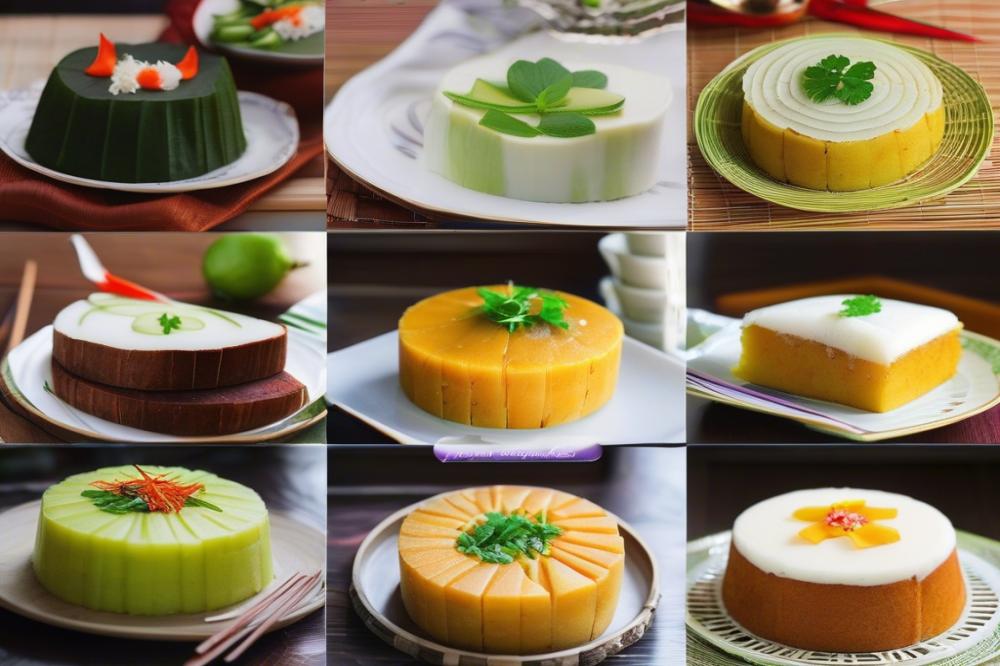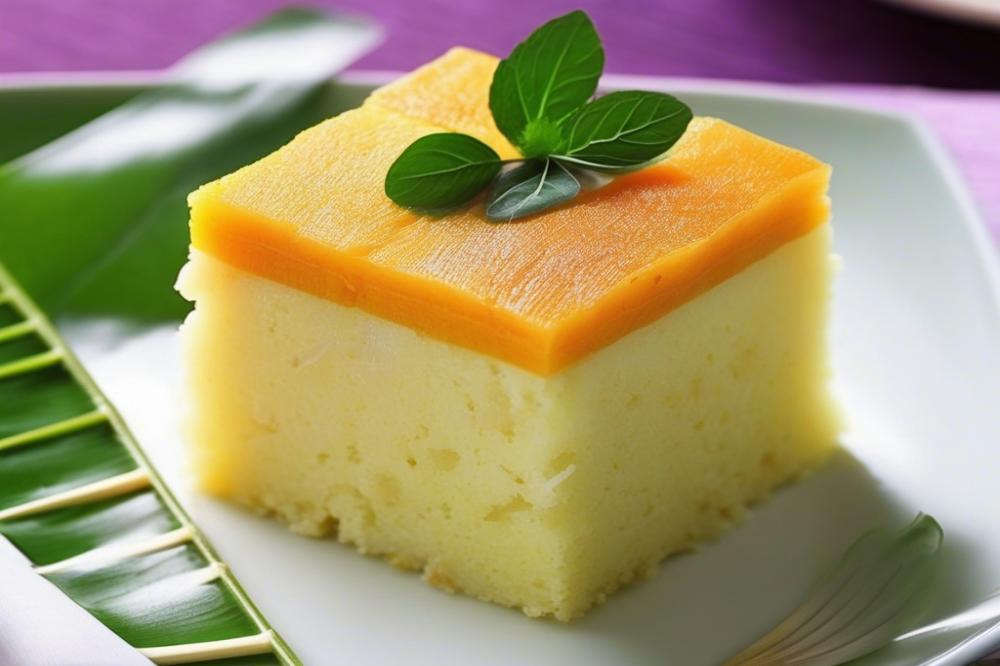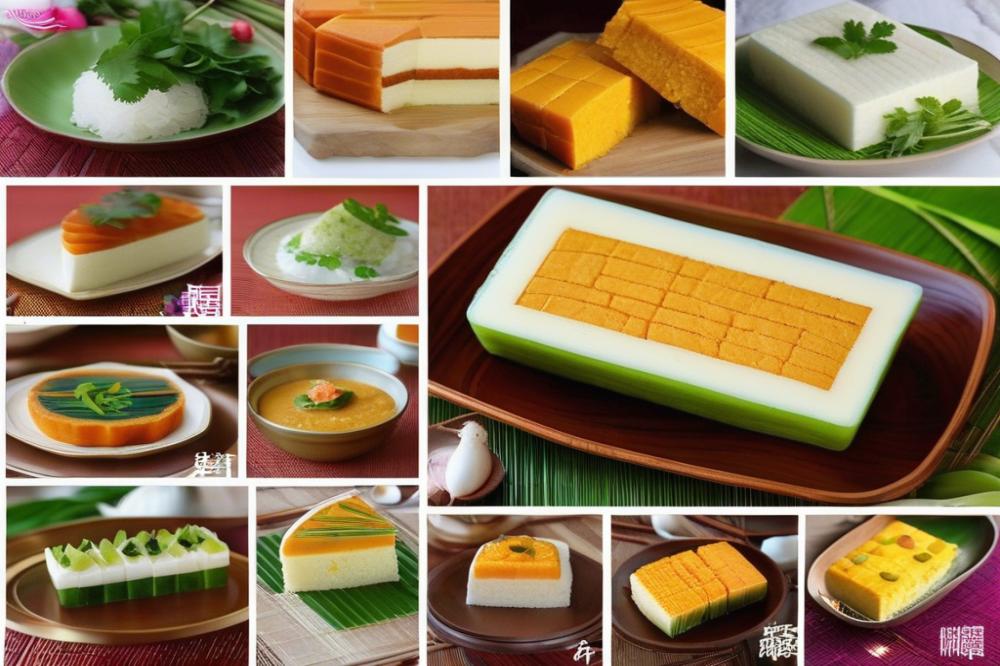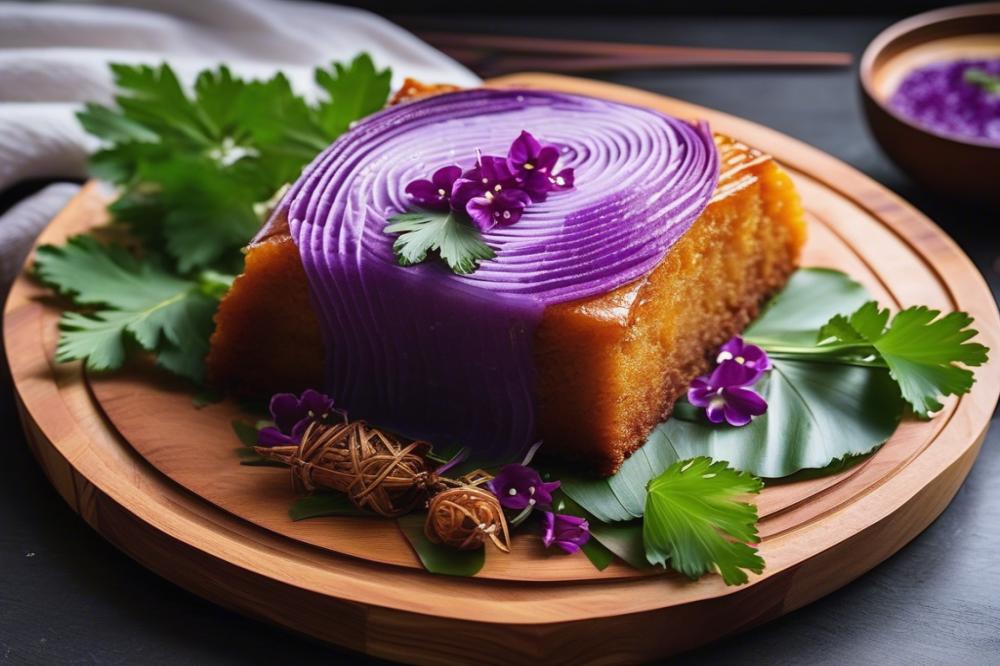recipebix.com/tau-foo-fah-recipe-silky-malaysian-tofu-dessert”>Yam Cake: A Beloved Delight in Malaysian Cuisine
Yam Cake is a cherished dish in Malaysian cuisine. Its popularity stems from a combination of savory flavors and an enticing texture. People often delight in its blend of yam and tapioca flour, which creates a moist and satisfying bite. This traditional dish is not just a meal; it plays a vital role in the culture and communal gatherings across Malaysia.
This dessert or snack brings comfort to many and is enjoyed by people of all ages. You can find it at food stalls, during special occasions, or even served at home as an everyday treat. The versatility of yam cake allows for various interpretations based on personal preferences or family recipes.
An appealing aspect is that yam cake is gluten-free, making it a fantastic option for those with dietary restrictions. It caters to a wide range of food enthusiasts, especially within the realm of Asian cuisine. Its steamed preparation offers a heartwarming and wholesome snack, rich in tradition and modern flair.
Whether paired with chili sauce or enjoyed plain, yam cake embodies the essence of Malaysian culinary heritage. Each bite is not just about flavor but also evokes memories of home and shared moments with loved ones. Discovering this delicious dish opens the door to a world of flavors and culture surrounding the Malaysian Steamed Cake experience.
What is Yam Cake?


Yam cake is a beloved dish often found in Asian cuisine. This savory treat is made mainly from yam and tapioca flour. Its preparation involves steaming the mixture to create a soft, dense texture. Traditionally, grated yam is combined with the flour to give the cake its distinct flavor and consistency.
The process starts with peeling and grating the yam. Once that is done, it is mixed with tapioca flour. Water is added to help form a batter-like consistency. Spices and flavorings add an extra touch. Ingredients like scallions, shiitake mushrooms, or dried shrimp enhance the taste further. After mixing, the batter is poured into a steaming tray. It is then placed in a steamer until it solidifies, which usually takes about 30 to 40 minutes.
This dish holds significance across various regions. In Malaysia, it is often served as a snack, enjoyed for breakfast or as a light meal. It is gluten-free, making it suitable for those with dietary restrictions. Across different Asian cultures, yam cake can vary. Some regions prefer sweeter versions that may incorporate sugar, transforming it into a dessert. Others might include more savory elements, reflecting local tastes and traditions.
In essence, yam cake showcases the adaptability of simple ingredients. This dish highlights the rich culinary heritage of Asian cuisine. Whether enjoyed alone or paired with sauces, it remains a staple that continues to delight many palates.
Ingredients and Cooking Instructions


To create this delightful steamed cake, gather the following ingredients:
- 500g yam (also known as taro) – This root vegetable is abundant in fiber and essential vitamins, making it a nutritious choice for your dish.
- 250g tapioca flour – Being gluten-free, it serves as a great alternative to wheat flour and is high in carbohydrates, helpful for energy.
- 500ml water – This ingredient is crucial for achieving the right consistency in the batter.
- 200g coconut milk – It brings creaminess and a rich flavor profile to the recipe, deepening the dish’s taste.
- 1 teaspoon salt – A small amount boosts the overall flavor of the cake.
- 1 tablespoon sugar (optional) – Using a little sugar can balance the savory aspects of the cake, making it more enjoyable.
- Optional toppings: Consider adding fried shallots, fresh coriander, or sliced chili for extra flavor and texture.
Now let’s explore the cooking process:
First, peel and steam the yam until it is soft. After steaming, mash it until there are no lumps left. In a separate mixing bowl, combine the mashed yam with tapioca flour. Stir in the water and coconut milk, followed by salt and sugar. Mixing these ingredients well is important, as it helps the batter become smooth.
Next, prepare a greased mold to hold the batter. Pour the mixture into this mold, ensuring it fills evenly. Place it in a steamer and let it cook for 30 to 40 minutes. This step is key; the steaming process gives the cake its special texture.
Once the time is up, remove the mold and allow the cake to cool completely. After cooling, slice it into pieces. You can serve the yam cake plain or elevate it further by adding optional toppings like fried shallots or chopped coriander for a unique touch.
This recipe has its roots in traditional Asian cuisine, making it a wonderful addition to your snack options or even as a dessert. Enjoy!
Nutritional Benefits of Yam Cake


Yam is the star ingredient in this savory dish, offering a wealth of nutritional benefits. Rich in dietary fiber, it aids digestion and helps maintain a healthy gut. This root vegetable also contains essential vitamins, such as vitamin C and vitamin B6, both of which support overall health. Eating yam can boost your immune system and contribute to energy metabolism in your body.
Tapioca flour plays an important role as well. This ingredient is a great option for those seeking gluten-free alternatives. It provides a smooth texture to the cake while keeping it light and airy. For individuals with gluten sensitivities, tapioca flour allows them to enjoy traditional recipes without concern.
Coconut milk, another key element, brings in a different dimension. It is known for containing healthy fats that promote heart health. Fats are vital for the body and help in the absorption of certain vitamins. Using coconut milk not only enhances flavor but also ensures that you benefit from its nutritional properties.
While savoring this delightful dish, portion control is essential. Even though yam cake can serve as a delicious snack or dessert, moderation is important. This recommendation holds true because maintaining a balanced diet leads to long-term health benefits. Keeping an eye on serving sizes allows you to enjoy this traditional Asian cuisine without overindulgence.
Serving Suggestions
Yam cake is a delightful dish that can be served in various ways. One of the most traditional accompaniments is chili sauce. This spicy addition enhances the flavors and adds an exciting kick. Soy sauce is another option that pairs well, offering a savory contrast that complements the steamed texture of the cake.
Enjoying this savory treat can be done warm or cold. Eating it warm allows for the flavors to shine, while a chilled version can be refreshing, especially on hot days. Many people appreciate the versatility of yam cake as a snack at any time of the day.
Pairing options are plentiful. A cup of tea makes for a pleasant companion, balancing the rich taste of the cake. As part of a meal, yam cake can serve as an appetizer or side dish, fitting seamlessly into a larger spread of Asian cuisine. It can also be a tasty alternative to typical desserts, providing a gluten-free option for those with dietary restrictions. The combination of yam and tapioca flour creates a satisfying texture that is hard to resist.
Consider serving the cake on a platter with an assortment of dipping sauces. Guests can personalize their experience by choosing their preferred sauce. Engaging in this interactive way adds an element of fun to any gathering.
Cultural Significance and Variations
The steamed cake holds an important place in Malaysian culture. Its presence is felt during special occasions, festivals, and family gatherings. People often prepare it as a savory snack, enjoyed during social events. Many families pass down recipes through generations, making it a part of their culinary heritage. Festivals like the Mid-Autumn Festival feature various treats, including this flavorful dish, symbolizing togetherness and abundance.
Regional variations of the dish can be quite diverse. In Penang, the cake is often richer, using more yam and infused with aromatic spices. Johor has a sweet twist by adding coconut, creating a balance of flavors. Nearby countries have their own takes too. In Singapore, for example, it is common to find a dessert version that replaces the savory elements with sweet toppings. This difference highlights the uniqueness found in each region’s interpretation.
Furthermore, comparing this dish to similar snacks in other Asian cuisines reveals fascinating similarities. Chinese cuisine features a dish called ‘taro cake,’ which uses taro root instead of yam. This recipe also uses tapioca flour to achieve a chewy texture. In Thailand, you might encounter ‘kanom tak,’ a dessert that, while different, shares some ingredients like coconut and rice flour. Each preparation style gives a distinct flavor profile while also showcasing the cultural significance of these foods in their respective countries.
Final Thoughts on Yam Cake
Yam cake stands as a cherished part of Malaysian cuisine. This savory steamed dish offers a wonderful blend of flavors that many people find irresistible. Made primarily from yam, it showcases the beauty of local ingredients and traditional cooking techniques. The dish is perfect for those seeking gluten-free options.
Every bite reveals a delightful texture and richness that can satisfy both snack cravings and dessert desires. Its unique taste brings warmth and comfort, making it a favorite at gatherings and family meals. Trying this recipe at home is an excellent way to connect with the culinary traditions of Malaysia.
These cakes can be served warm or at room temperature, adding to their versatility. Friends and family often enjoy yam cake together, celebrating its cultural significance. Exploring how to make this delicious dish opens doors to discovering the rich flavors of Malaysian heritage. If you have not yet had the chance, now is the perfect time to give it a try. Making yam cake allows you to experience something truly special from Malaysia’s vibrant food scene.



